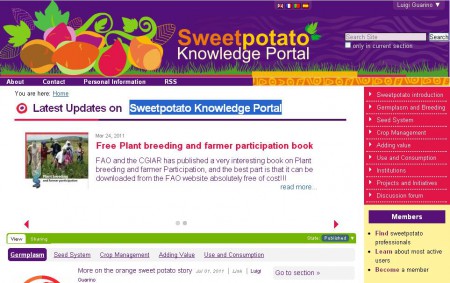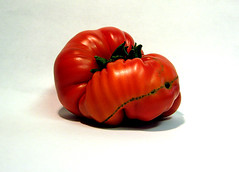If you were intrigued by news of a BBC series on the history of botany, but could not see it because you don’t live in the UK, fear not, Jeremy has snipped out the bit about Vavilov that appeared in the third programme, which was all about crop breeding.
An online home for sweet potato information
There’s a new online Sweetpotato Knowledge Portal. Lots of stuff on germaplasm conservation, breeding, seed systems, value addition etc. It really does look quite interesting, but, frustratingly, I have no idea who’s behind it. Institutionally, that is. There’s not a logo in sight anywhere. Seems to be driven by sweetpotato researchers themselves, many, but by no means all, at CIP. I shall be watching it closely, via its RSS feed.

Even heirloom tomatoes may not be what they seem
![]() Oh, pesky scientists! A bunch of them in Spain has taken a close look at one of the darlings of European tomato culture and found it, how shall we say, disappointing. 1 The subject of their investigation was a type of tomato known as Marmande, associated with the town of that name. There are several landraces of Marmande tomatoes, and in northeast Spain two of them, Montserrat and Pera Girona, are grown in adjacent areas. Each has its favoured consumers, who argue that their Marmande is better than the others’, although both Montserrat and Pera Girona are apparently facing competition in their respective niches from upstart Marmande tomatoes from France, Italy and elsewhere in Spain.
Oh, pesky scientists! A bunch of them in Spain has taken a close look at one of the darlings of European tomato culture and found it, how shall we say, disappointing. 1 The subject of their investigation was a type of tomato known as Marmande, associated with the town of that name. There are several landraces of Marmande tomatoes, and in northeast Spain two of them, Montserrat and Pera Girona, are grown in adjacent areas. Each has its favoured consumers, who argue that their Marmande is better than the others’, although both Montserrat and Pera Girona are apparently facing competition in their respective niches from upstart Marmande tomatoes from France, Italy and elsewhere in Spain.
The researchers note that:
Often without experimental confirmation, many consumers consider that everything “traditional” tastes better than improved varieties.
 And they’re not going to stand for that. So, they went to growers and got samples of the two kinds of Marmande, a couple of controls from further afield, and some commercial varieties, grew them in the field and evaluated the hell out of them, including a slew of molecular tests. And here’s the bad news; while the controls and far-off Marmandes were quite distinct from one another and from Montserrat and Pera Girona on molecular data, those two could not be separated from one another, favoured consumers be damned. There were differences in the outward look of Montserrat and Pera Girona, but within each landrace the range of scores on sensory traits (what consumers are probably “preferring”) was far greater than any differences between the two.
And they’re not going to stand for that. So, they went to growers and got samples of the two kinds of Marmande, a couple of controls from further afield, and some commercial varieties, grew them in the field and evaluated the hell out of them, including a slew of molecular tests. And here’s the bad news; while the controls and far-off Marmandes were quite distinct from one another and from Montserrat and Pera Girona on molecular data, those two could not be separated from one another, favoured consumers be damned. There were differences in the outward look of Montserrat and Pera Girona, but within each landrace the range of scores on sensory traits (what consumers are probably “preferring”) was far greater than any differences between the two.
There are differences, of course, mostly in what the two varieties look like. Montserrat has flattened fruit, while Pera Girona is pear-shaped. So, what’s going on? Farmers are clearly selecting to conform to the landrace stereotype, but not much else.
[T]he recent evolution of these tomato landraces has resulted in uniform fruit morphology and wide variation in texture, aroma, and taste. It seems farmers have selected seeds solely on the basis of fruit morphology, neglecting sensory traits. Texture, aroma, and taste do not correlate with the shape of the fruit; thus, the persistence of separate markets for these varieties is exclusively due to morphological differences in the fruit. It seems that consumers continue to identify certain morphologies with superior quality.
And this is by no means a unique phenomenon.
Selection for morphological traits while neglecting sensory traits seems to be practiced widely: variability in sensory attributes related to a genetic base has been reported in beans … and in eggplant. … In other cases, variability in sensory traits is related to cultivation practices, as in the RAF tomato, which can be acid, sweet, and crisp when cultivated in salty soils but of poor sensory value when cultivated in high yielding soils. As a result of cultivation expansion, the prestige of RAF tomatoes blossomed and wilted in a short time.
Inevitably, then, consumers are going to be disappointed by their chosen landrace at least some of the time. What’s to be done?
In order to consolidate the market, the link between organoleptic and morphological traits must be maintained and reinforced.
In other words, get back to basics: gather a group of keen consumers, identify what it is about each variety that attracts them, and then start selection to make sure that the tomatoes deliver more than appearance. As good as their word, the scientists have already done this for Pera Girona, and they say that just one round of selection has already “resulted in an improved inbred line”.
Ah, but is it still a traditional landrace?
Nibbles: Seed mothers, Bees, Strawberry, Chilli collection, Talk on agrobiodiversity
- Need seed? Ask a bihana-maa, at least if you are in Orissa.
- Decline in UK honeybees reveals that crops not so dependent on them after all. Huh?
- A new strawberry for aesthetically-minded home gardeners.
- Wild Chilli group of Europe to visit Experimental Garden and Genebank of the Radboud University of Nijmegen. Send us a report?
- A free talk about the importance of perpetuating food plant resources for the future on Thursday, July 14. Oh, it’s on Hawaii. Send us a report?
Africa’s Green Revolution: A report from the barricades
Jacob van Etten has sent in this post, with the following disclaimer: I contributed one of the articles to the issue and participated in a preparatory workshop. My own addition to this issue highlights the role of ICT technologies to create new networks of collaboration around technological innovation, creating new links between scientists and farmers. Luigi will give his own critical assessment of that piece in a separate post.
The Alliance for a Green Revolution in Africa, the Milennium Villages Program and the new Feed the Future program are all busy to make a new Green Revolution happen in Sub-Saharan Africa. These initiatives promote similar combinations of better access to inputs such as fertilizers and improved varieties, including the development of input markets so that the inputs keep getting to the farms in the future, too.
 The latest issue of the IDS Bulletin reports from the ground on these African Green Revolution initiatives. The issue contains interesting field studies from Malawi, Ethiopia, Kenya, Zimbabwe and Ghana. The focus is not that of traditional impact evaluation, though. The studies look at how the different projects take shape through an institutional, political lens. How are local alliances shaped to realize the objectives of these programs? And whose interests are being served anyway?
The latest issue of the IDS Bulletin reports from the ground on these African Green Revolution initiatives. The issue contains interesting field studies from Malawi, Ethiopia, Kenya, Zimbabwe and Ghana. The focus is not that of traditional impact evaluation, though. The studies look at how the different projects take shape through an institutional, political lens. How are local alliances shaped to realize the objectives of these programs? And whose interests are being served anyway?
The stories that emerge are tremendously diverse and well worth reading. For instance, Kenya, with its strong but unevenly developed private seed sector, versus Ethiopia‘s still largely state-controlled system give very different contexts to work in. Especially fascinating is the study on Malawi. Malawi has been a poster child for its input subsidy programme. Blessings Chinsinga investigates how this plays out on the ground.
One of the lessons is that seed market development, as promoted by the different African Green Revolution initiatives, is supply-driven rather than demand-driven. For agrobiodiversity, this means that the supply often becomes reduced to a few modern varieties, even though there might be demand for a more diverse set of seeds.
There is very little evidence that the different projects were designed explicitly taking the political-economic diversity on the ground into account. As a consequence, the different interventions seem to do little to change local power balances or place agricultural innovation on a more democratic footing. Therefore, Ian Scoones and John Thompson, in the introductory article, call for more democratic deliberation on these issues, so that more diverse perspectives come to the table.
To me it seems that we need fairly radical new ways to make the voices of farmers heard and to prevent certain elites from undermining the process. Even supposedly democratic deliberations are often hijacked by elite opinions as a result of cultural conventions, verbal assertiveness and so on. Perhaps we should promote less a “talking” democracy and more a “doing” democracy. 2 Democratic processes that tap into the expert knowledge of farmers may be less easy to hijack by non-experts, such as business elites. Vote with your seed.